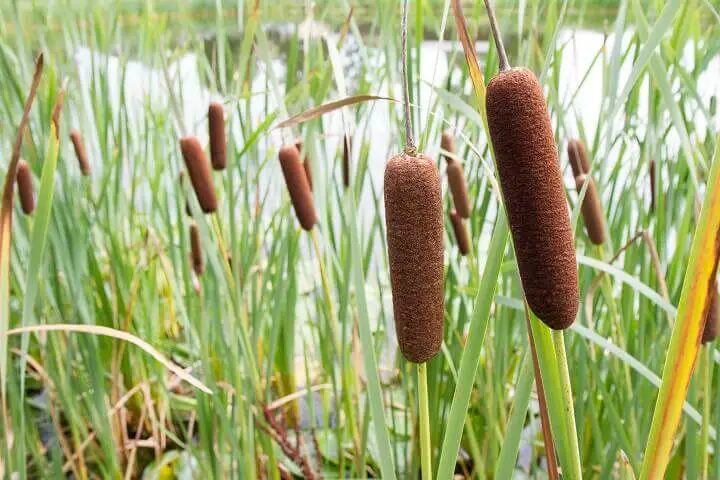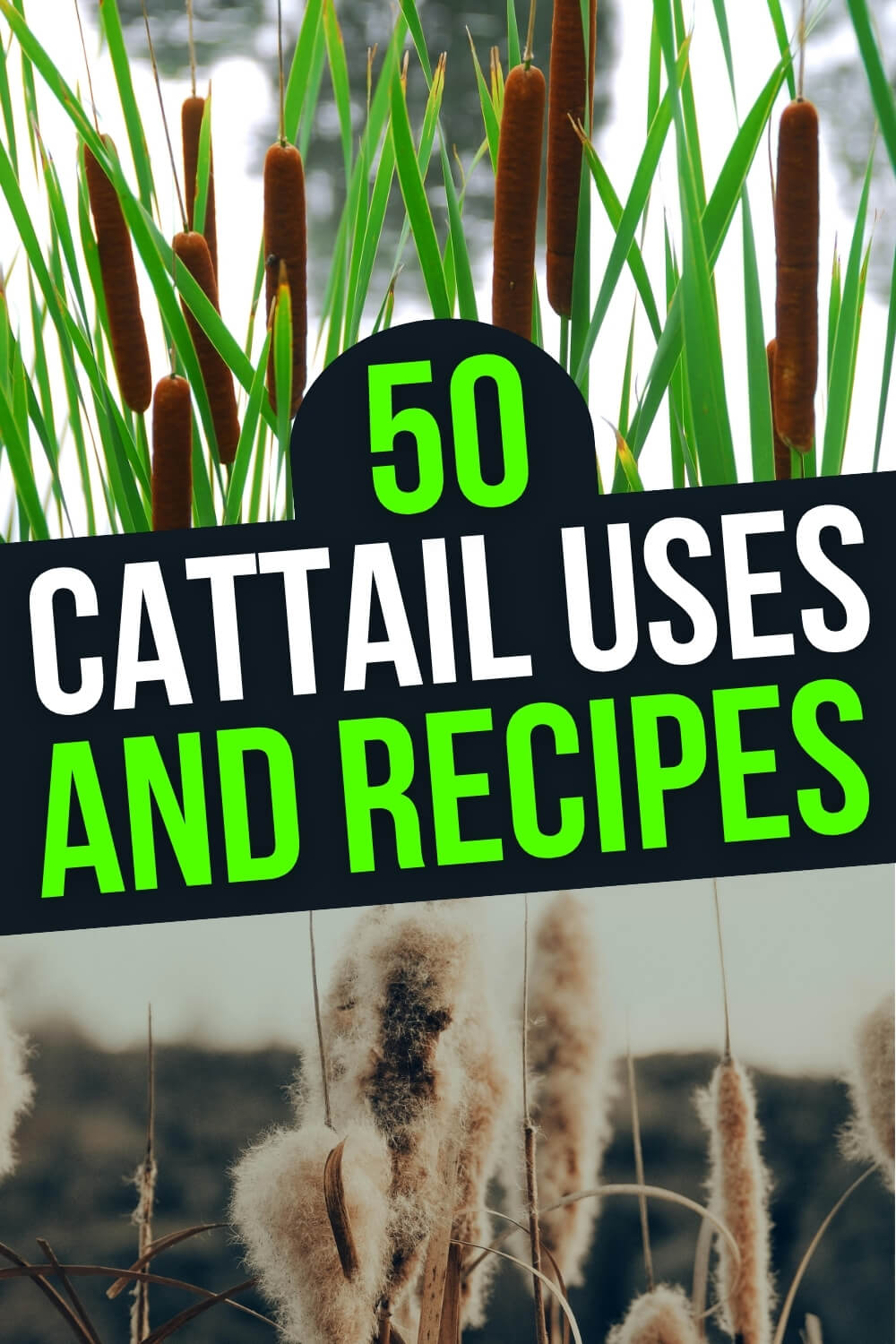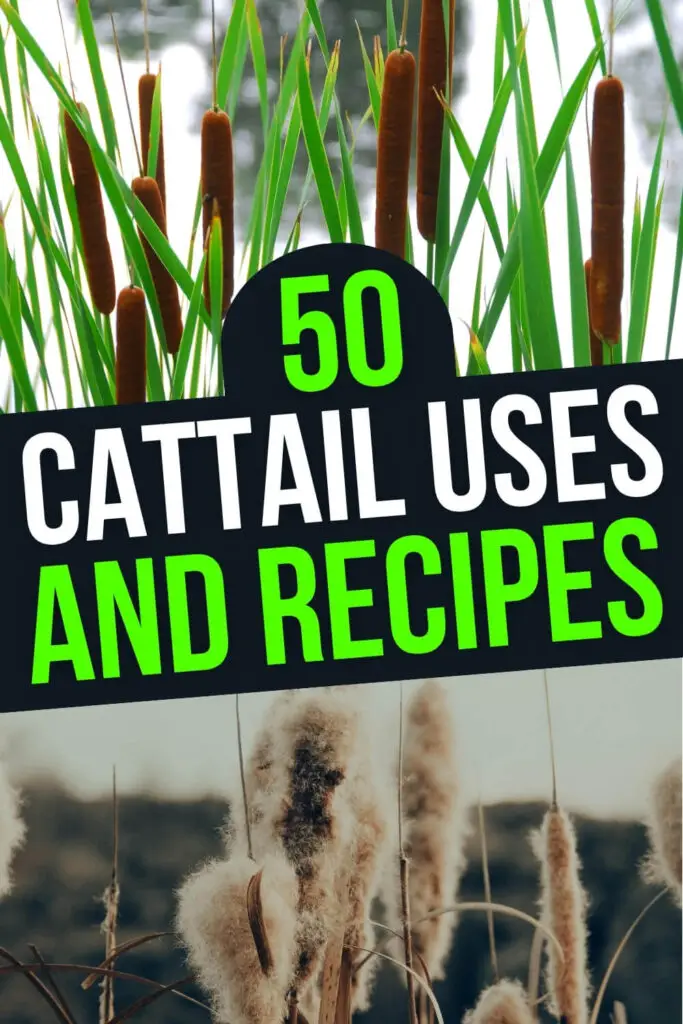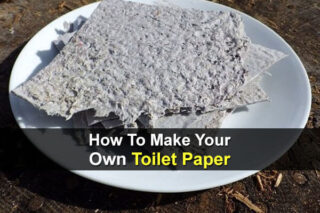Estimated reading time: 11 minutes
Cattails might just be a prepper’s dream plant. If you are a survivalist, prepper, homesteader, or history buff, you’ll want to learn about cattails. But if you have to bug out or find yourself lost in the woods, finding a cattail colony means you have found some essential items that will help you to survive: food, shelter, water, and heat.
There are dozens of uses for the humble cattail. They can be used as food, to build an emergency shelter, make fires, baskets, twine, and so much more. If you are going to consume a cattail, make sure you can positively identify it, so you don’t ingest a toxic look alike.
In this article, we’ll talk about cattails and their many uses. We’ll look at how to use cattails for food, to make baskets and other textiles, and how to use them to start fires and make torches. But first, we’ll look at what a cattail is and how to identify them.
Want to save this post for later? Click Here to Pin It On Pinterest!
I loved to pull apart the brown, hotdog-shaped cattails and throw the fluffy stuff into the wind as a kid. I didn’t know back then that those brown catkins were the hallmark identifier of a cattail.
Known by a myriad of nicknames like bulrush, water torch, corn dog grass, and of course, cat-o-nine tails, these tall plants in the grass family are easy to identify if you know what to look for.
Identifying Cattails
Cattails (Typha species) are one of the easiest wild plants to identify. If you live in the Northern Hemisphere and can find a body of water like a lake, pond, marsh, wet ditch, or even just soggy soil, you’re likely to find cattails growing nearby. They thrive in saturated ground and often grow in dense colonies.
Key Features to Look For
- Blade-like Leaves: Cattail leaves are long, flat, and blade-like, resembling oversized grass. They typically grow between 5–8 feet tall and have a soft, almost waxy texture. The leaves rise vertically in fans from the base and can be easily separated by hand.
- Cigar-shaped Flower Heads: The most distinctive feature of the cattail is its brown, cylindrical flower spike (the “cattail”). This dense, sausage-like head grows at the top of a stiff central stalk and is completely unique to the plant. When mature, the flower heads burst open and release a thick mass of fluffy seeds.
- Rhizomes and Roots: If you pull one up, you’ll find long, starchy rhizomes that grow horizontally through the mud. These rhizomes are what anchor the plant and serve as its main carbohydrate reserve.
- Tender Inner Stalk (Cattail Heart): Just above the root, hidden under the outer leaves, is a tender white stalk known as the “heart.” It has a mild, cucumber-like flavor and is edible raw or cooked. When peeled, the inner layers can reveal a clear, jelly-like sap that acts as a natural antiseptic.
Common Look-Alikes and Safety Note
Young cattail leaves can resemble other marsh plants, especially blue flag iris, which is toxic if ingested. However, irises lack the signature flower head. To safely confirm a cattail patch, look for the brown cigar-shaped seed heads, no other plant has them. If you’re harvesting early in the season before the heads appear, use caution and only harvest from known patches.
Harvest Considerations
Because cattails are natural water filters, they absorb toxins from the soil and water around them. While this is great for the ecosystem, it means you should never harvest cattails from stagnant or polluted water, roadside ditches, or urban runoff areas. Always choose clean, remote wetlands or ponds for foraging.
If you want, you can grow cattails yourself in any swampy area, even in a container if the soil is wet enough. There are many ways that you can use cattails around the house for prepping and for survival purposes. Here are just a few.
Cattails as a Food Source
Cattails make an excellent and highly versatile food source. All parts of the plant can be eaten. Of course, ripe catkins are full of fluff which might not be too tasty!
Cattails produce more edible starch than rice or potatoes, making them a good source of calories. The fresh shoots have a flavor similar to peppery cucumbers. This supermarket plant can be eaten in a variety of ways.
- Cattail “Cobs” in Season – When the green male flower spike matures but is still soft, it can be boiled or steamed and eaten much like corn on the cob. It has a nutty, slightly cucumber-like taste and is rich in protein.
- Roots – Roots provide plenty of starchy carbohydrates and can be harvested any time of year. You’ll find them buried in mud and wet soil, so be prepared to get muddy.
- Rhizomes – The starchy rhizomes can be dried and pounded into flour or boiled.
- Hearts – The heart of the cattail is located just above the rhizome. Early in the season, it can be cooked and eaten similarly to a Jerusalem artichoke. As the plant matures, though, this part might become to fibrous to eat.
- Shoots – New shoots are full of vitamins and can be eaten raw or cooked.
- Seeds – Cattail seeds can be ground up to make a substitute for flour.
- Flowers – Young cattail flowers can be cooked and eaten similarly to corn on the cob.
- Cattail Pollen – Cattails produce large amounts of pollen, which can replace some or all of the flour in recipes for an excellent source of protein, vitamins, and minerals.
- Cattail Jelly – While not as common, cattail pollen and starch can be mixed with fruits like wild berries to create nutrient-dense survival jellies. The pollen helps thicken and add protein to the jelly.
- Tea From Roots – The roots can be chopped, dried, and steeped into a light tea that may offer mild antiseptic and diuretic properties. While not especially flavorful, it’s a resourceful wilderness beverage.
For cattail recipes, check out the farmer’s almanac.
Cattails as a Textiles Source
Cattail leaves and stalks are sturdy and versatile, making them a resource for crafting and weaving. The fluffy catkins are highly absorbent and insulating, as well.
- Diapers – The fluffy flower pods are highly absorbent and have been used as diapers for this reason.
- Feminine Hygiene Products – These absorbent flowerheads are also used in a similar way to menstrual pads.
- Insulation – Sleeping bags and comforters can lose their fluff over time, but you can give them a little extra life by filling them back up with the fluff from cattails. Check out just how much fluff cattails can make in this video here. During WW2, children collected cattails to stuff life jackets and sleeping bags because of their insulating power.
- Shoes and hats – If you are caught in the cold, you can keep your hands and feet a little extra warm by lining your shoes and gloves with dry cattail fluff. You could even line your clothes and coat, if needed.
- Stuffing – The fluffy seeds can also be used to stuff pillows, mattresses, and other craft items. Just make sure it is completely ripe and dry first for the best amount of fluff.
- Baskets – The stalks of cattails can be woven together to make baskets for storage and transporting items. The stems and leaves are strong and fibrous, which will give support to your items.
- Twine and Survival Rope – This tough, fibrous material can be twisted into a twine or rope in a pinch, which you can use for fishing, making tools, or building a survival shelter.
- Mats – Just like baskets, the stalks can be woven into sleeping mats or placemats for comfort. Allow the leaves to dry completely, then soak them for a short time to make them more pliable.
- Hats – If you need some shade in the hot sun, you can weave dried cattail leaves together to make a primitive and cooling hat.
- Paper Making – Dried cattail leaves and stalks can be processed into pulp and turned into rough paper, useful for note-taking, wrapping, or fire-starting material.
- Windbreak Panels – Weave cattail leaves between wooden poles or branches to create windbreaks or primitive walls for temporary structures.
- Sleeping Bags or Pads – Bundle and tie cattail fluff in tight cloth sacks or old clothes to create primitive sleeping bags or cushions. It's not modern insulation, but it helps keep body heat in during a survival situation.
Cattails for Heat and Light
- Firestarter – The fluffy seeds are easy to light, making them an excellent Firestarter for cold nights.
- Torch – The dried stalks can be used as torches when you light the tip of a dried seed pod.
- Kindling – If you need a quick fire, you can burn dried stalks as kindling.
- Candle Wick Material – The fluffy seed heads can be twisted and dipped in tallow or wax to make primitive candle wicks. They burn well and are easy to craft in the wild.
- Oil Lamp Wick – Similar to candles, a cattail stalk or fluff-twist can be soaked in oil (like rendered animal fat or plant oil) and used as a wick in a basic container lamp.
Cattails for Medicinal Use
- Antiseptic – Two forms of antiseptic can be derived from a cattail. First, ashes from burned cattail leaves and sap droplets from the plant base can be applied to wounds to prevent infection.
- Toothache Reliever – The sap from this plant can be used to relieve the pain of a toothache.
- Cotton Balls – The fluff from the seeds can be used like cotton balls to stop bleeding.
- Poultices – Poultices can be made from crushed roots to use on small wounds, stings, and burns.
- Stomach Issues – It is said that cattail seeds can be used to stop diarrhea.
- Burn Dressing – Cattail fluff can be applied directly to minor burns as a dry, sterile covering. Its absorbent nature helps keep wounds dry while reducing infection risk.
- Crushed Leaf Bug Repellent – Crushing and rubbing the leaves on your skin can offer a mild bug-repelling effect, especially against gnats and no-see-ums. Not as strong as DEET, but useful in a pinch.

Other Uses for Cattails
- Emergency Shelter – If you’ve found cattails, you’ve also found an emergency shelter. Create a teepee-shaped dome with cattails. Tie several cattail stalks together at the top to create a teepee shape, and then continue layering them until you’ve reached the desired thickness. This will provide some shelter from wind, rain, and cold. You can insulate the bottom and sides of the teepee with dried stalks and cattail fluff.
- Fishbait – The cattail is home to beetle grubs that make excellent fish bait. Look underneath the lower leaves near the stalk to find them.
- Chopsticks – If you need utensils, the stiff stalks of the cattail can be fashioned into safe chopsticks.
- Arrow Shafts – The stiff stalks make study shafts for arrows.
- Hand Drills – The stalks are stiff and sturdy enough to be fashioned into primitive tools, such as hand drills.
- Erosion Control – Erosion can happen quickly in swampy areas. Planting cattails can help hold in the soil. And cattails can be the first step in turning a soggy area into a usable, dryer location as they hold in soil that can build up over time.
- Waterway Cleanup – Cattails are known for their ability to bioaccumulate toxins from water and soil. As a result, they can remove chemicals such as arsenic, phosphorous, methane, and even explosives.
- Crop Protection – Farmers will sometimes plant them in boggy areas between roads and fields to reduce pollution and crop contamination.
- Privacy Screen – These tall, grassy plants can be thickly planted in containers to create a privacy screen to shield you from the view of neighbors and passersby.
- Cattails for Decorating – These pretty brown flower heads are often used in flower arrangements and wreath making. The flower heads will last indefinitely.
- Glue – The stalks can be used to make a type of glue.
- Fireworks – The pollen of the flower is sometimes used as a coloring agent in fireworks.
- Livestock – The dried stalks can be used as bedding for your homestead animals, and the young shoots can be fed to goats as a supplemental feed.
- Water Filtration Pre-Filter – In survival scenarios, cattail fluff and roots can act as a basic pre-filter to remove sediment before boiling or purifying water. It won’t kill bacteria, but it helps clear debris.
- Navigation Marker – Use bundles of cattail stalks to mark trails or signal locations. The tall, distinctive shape stands out in brush or wooded terrain.
- Cushioned Footwear – In cold weather or rugged terrain, stuffing cattail fluff into your shoes can help insulate your feet and prevent blisters from rough materials.
Whenever you forage for food, you need to be entirely sure that you correctly identify an edible plant. And although the young leaves are easily confused with other plants that are not safe to eat, you can tell a cattail by its brown, cigar-shaped flower. Always do your research, so you are confident in your ability to use this fantastic and versatile plant.
Like this post? Don't Forget to Pin It On Pinterest!
You May Also Like:













